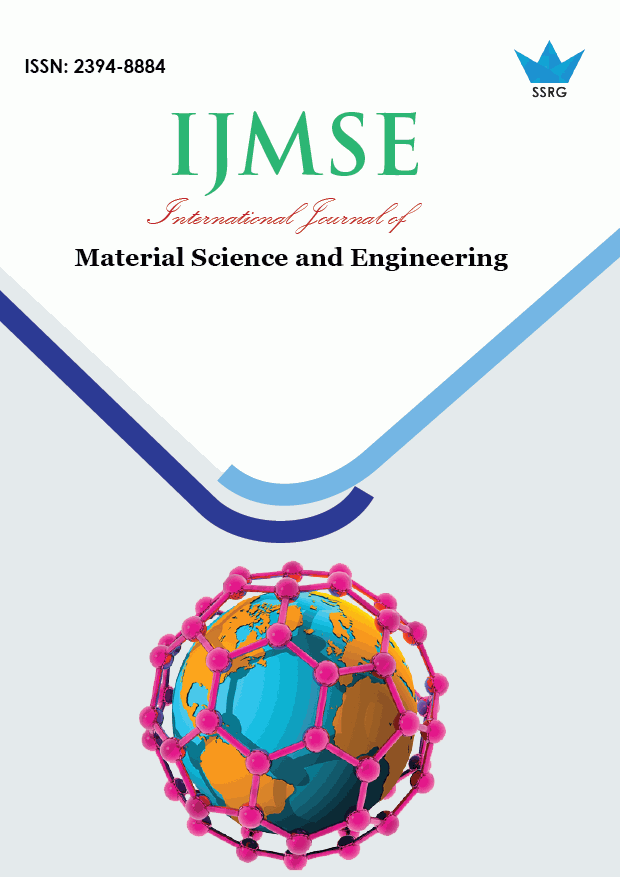Optical Properties of PbSe, PbS, and PbTe Semiconductor Quantum Dots and their Applications

| International Journal of Material Science and Engineering |
| © 2024 by SSRG - IJMSE Journal |
| Volume 10 Issue 2 |
| Year of Publication : 2024 |
| Authors : H. I. Ikeri, S. T. Harry, E. I. Achuka, C N. Eze, O. K. Asielue, N. D. Ndubueze |
How to Cite?
H. I. Ikeri, S. T. Harry, E. I. Achuka, C N. Eze, O. K. Asielue, N. D. Ndubueze, "Optical Properties of PbSe, PbS, and PbTe Semiconductor Quantum Dots and their Applications," SSRG International Journal of Material Science and Engineering, vol. 10, no. 2, pp. 19-23, 2024. Crossref, https://doi.org/10.14445/23948884/IJMSE-V10I2P103
Abstract:
Optical properties of PbSe, PbS, and PbTe semiconductors in confinement regimes have been studied using the Brus equation. The results indicate that QDs exhibit size-dependent optical behavior and, hence, tunable bandgaps and emission wavelengths as a consequence of quantum confinement. As the QD size decreases, the absorption edge and emission peak are blue-shifted for all three materials. It is found that PbSe QDs display significant quantum confinement even at larger sizes. Due to its relatively large exciton Bohr radius (~46 nm), as the size decreases from 10 nm to 2 nm, the bandgap increases from 0.27 eV to over 1 eV, shifting absorption and emission into the near-infrared (NIR), leading to applications into NIR photodetectors, solar cells, and biomedical imaging. Also, PbS QDs exhibit significant quantum confinement effects at smaller sizes due to their smaller exciton Bohr radius (~20 nm) compared to PbSe. The bandgap increases from 0.41 eV to around 1.5 eV as the size decreases from 10 nm to 2 nm, shifting absorption and emission from the NIR into the visible range. This is utilized in solar cells, visible to NIR photodetectors and LEDs. Furthermore, PbTe QDs also exhibit pronounced quantum confinement effects because of their relatively large exciton Bohr radius (~46 nm). The bandgap increases from 0.32 eV to around 1 eV as the size decreases from 10 nm to 2 nm, shifting absorption and emission into the NIR and Mid-Infrared (MIR) regions, making them excellent materials for infrared detectors, thermoelectric and MIR applications. Among the semiconductor materials studied, PbS QD typically exhibits the largest increase in bandgap with decreasing size, making them suitable for applications requiring larger bandgap tunability, followed by PbSe and PbTe. These different optical characteristics are due to their unique electronic properties and exciton Bohr radii.
Keywords:
Quantum dot, Quantum confinement, Charge carrier, Brus equation, Optical properties, Bandgap.
References:
[1] Shengdong Zhang et al., “A Novel Ultrathin Elevated Channel Low-Temperature Poly-Si TFT,” IEEE Electron Device Letters, vol. 20, no. 11, pp. 569-571, 1999.
[CrossRef] [Google Scholar] [Publisher Link]
[2] Moungi G. Bawendi, Michael L. Steigerwald, and Louis E. Brus, “The Quantum Mechanics of Larger Semiconductor Clusters (“Quantum Dots”),” Annual Review of Physical Chemistry, vol. 41, pp. 477-496, 1990.
[CrossRef] [Google Scholar] [Publisher Link]
[3] L. Banyai, and S.W. Koch, Semiconductor Quantum Dots, World Scientific Series on Atomic, Molecular and Optical Physics, 1993.
[CrossRef] [Google Scholar] [Publisher Link]
[4] C.B. Murray, D.J. Norris, and M.G. Bawendi, “Synthesis and Characterization of Nearly Monodisperse CdE (E = Sulfur, Selenium, Tellurium) Semiconductor Nanocrystallites,” Journal of American Chemical Society, vol. 115, no. 19, pp. 8706-8715, 1993.
[CrossRef] [Google Scholar] [Publisher Link]
[5] L.E. Brus, “Electron-electron and Electron-hole Interactions in Small Semiconductor Crystallites: The Size Dependence of the Lowest Excited Electronic State,” The Journal of Chemical Physics, vol. 80, pp. 4403-4409, 1984.
[CrossRef] [Google Scholar] [Publisher Link]
[6] M.T. Nenadovic, T. Rajh, and O.I. Micic, “Size Quantization in Small Semiconductor Particles,” The Journal of Physical Chemistry, vol. 89, no. 3, pp. 397-399, 1985.
[CrossRef] [Google Scholar] [Publisher Link]
[7] Ephrem O. Chukwuocha, Michael C. Onyeaju, and Taylor S.T. Harry, “Theoretical Studies on the Effect of Confinement on Quantum Dots Using the Brus Equation,” World Journal of Condensed Matter Physics, vol. 2, no. 2, 2012.
[CrossRef] [Google Scholar] [Publisher Link]
[8] Yasuaki Masumoto, and Koji Sonobe, “Size-dependent Energy Levels of CdTe Quantum Dots,” Physical Review B, vol. 56, 1997.
[CrossRef] [Google Scholar] [Publisher Link]
[9] S.T. Harry, and M.A. Adekanmbi, “Confinement Energy of Quantum Dots and The Brus Equation,” International Journal of Research - Granthaalayah, vol. 8, no. 11, pp. 318-323, 2020.
[CrossRef] [Google Scholar] [Publisher Link]
[10] Andrew M. Smith, and Shuming Nie, “Semiconductor Nanocrystals: Structure, Properties, and Band Gap Engineering,” Accounts of Chemical Research, vol. 43, no. 2, pp. 190–200, 2010.
[CrossRef] [Google Scholar] [Publisher Link]
[11] H.I. Ikeri, A.I. Onyia, and V.C. Onuabuchi, “Bandgap Engineering of the II-IV, III–V and IV–VI Semiconductor Quantum Dots for Technological Applications,” International Journal of Engineering and Applied Sciences, vol. 8, no. 7, pp. 1-6, 2021.
[Google Scholar]
[12] Madan Singh, Monika Goyal, and Kamal Devlal, “Size and Shape Effects on the Band Gap of Semiconductor Compound Nanomaterials,” Journal of Taibah University for Science, vol. 12, no. 4, pp. 470-475, 2018.
[CrossRef] [Google Scholar] [Publisher Link]
[13] Nisha Pandey, Amrita Dwivedi, and Arunendra Patel, “Theoretical Study of Dependence of Wavelength on Size of Quantum Dot,” International Journal of Scientific Research and Development, vol. 4, no. 1, pp. 1158-1159, 2016.
[Google Scholar] [Publisher Link]

 10.14445/23948884/IJMSE-V10I2P103
10.14445/23948884/IJMSE-V10I2P103